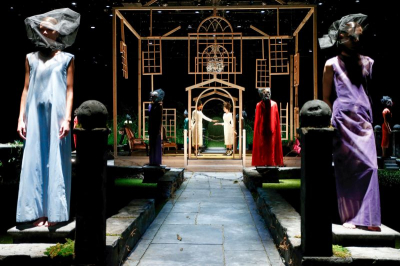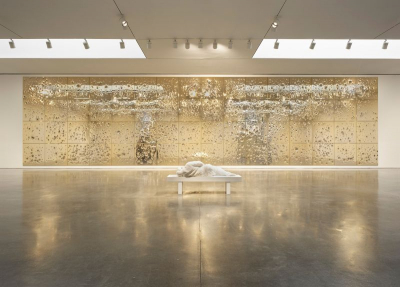Once annually, the hallowed steps of New York’s Metropolitan Museum of Art, fondly known as "the Met," undergo a transformation into the epicenter of the most scrutinized costume affair of the year. The Met Gala, renowned for its extravagant themes, has delved into profound topics over the years, from international relations ("China: Through the Looking Glass," 2015) to the visual narrative of Catholicism ("Heavenly Bodies: Fashion and the Catholic Imagination," 2018), and even the intersection of art and technology ("Manus x Machina: Fashion in an Age of Technology," 2016).
This year, under the guidance of Andrew Bolton, the esteemed curator of the Met's Costume Institute, celebrity guests are summoned to unravel the enigmatic prose of science fiction luminary J.G. Ballard. In a bold move, the Met unveiled Ballard’s 1962 short story, "The Garden of Time," as the gala's forthcoming theme. This narrative will interlace with the main exhibition, dubbed "Sleeping Beauties: Reawakening Fashion," showcasing centuries-spanning pieces from the Costume Institute's archive. Many of these artifacts, delicate and precious, now require preservation measures to prevent deterioration, a testament to their historical significance.
In "The Garden of Time," readers are transported to a grand Palladian villa inhabited by Count Axel and his spouse, nestled within a sprawling walled estate. Across the estate's expanse, a mesmerizing meadow of crystalline "time flowers" unfurls, each blossom possessing the ability to reverse the passage of time. Count Axel, in a ritualistic gesture, plucks these ethereal blooms daily, rewinding time to thwart the encroaching threat of an angry mob inching closer to their sanctuary. However, the inevitability of decay casts a looming shadow over the narrative, culminating in the grim discovery of the villa's ruins and two stone statues resembling the Count and Countess.
Arguably one of Ballard's most enigmatic tales, "The Garden of Time" delves into themes of decay, beauty, and fragility, echoing the underlying motifs of the "Sleeping Beauties" exhibition. As guests prepare to traverse the metaphysical landscape of Ballard's imagination on the red carpet, the Gala promises to be a poignant exploration of the intricate relationship between fashion, time, and the human condition.
In Ballard's universe, there's a distinct absence of glitz and glamour—or if it briefly flickers, it's swiftly extinguished. Since the 1950s, the British author, who passed away in 2009, forged a literary legacy fixated on dystopian nightmares, unrelenting violence, and the disintegration of bourgeois sensibilities. Whether his narrative unfolds within the confines of a luxury high-rise or amidst the opulence of a gated community in the French Riviera, Ballard's central argument remains unyielding: the veneer of upper-middle-class existence is fragile, teetering on the brink of collapse.
Even if his name doesn't ring a bell, chances are you've encountered Ballard's unsettling explorations of the human psyche. Consider Steven Spielberg's 1987 cinematic adaptation of Ballard's 1984 novel, "Empire of the Sun," a semi-autobiographical account of his childhood internment in a Chinese camp during World War II. Or David Cronenberg's controversial 1996 film rendition of Ballard's 1974 novel, "Crash," depicting a group of individuals erotically fixated on automobile accidents—an interpretation that elicited boos and early exits at its Cannes Film Festival premiere.
Yet, Ballard's influence extends far beyond the realm of cinema. His worldview permeates art, music, architecture, and, notably, fashion, perhaps more persistently than any other 20th-century writer. Fashion designers, in particular, find themselves drawn to Ballard's evocative vision. In 2021, Thom Browne's Spring-Summer runway at New York Fashion Week offered a glimpse into life behind the walls of Count Axel's garden. Browne evoked the story's haunting conclusion with silk-screened T-shirt dresses adorned with Greco-Roman statuary and streaks of clay, symbolizing the narrative's decay.
Similarly, Israeli designer Alon Livné found inspiration in Ballard's 1966 novel, "The Crystal World," while London-based Andrew Groves debuted a Spring-Summer collection in 1998 inspired by Ballard's 1997 tale of debauchery and murder in Estrella de Mar, "Cocaine Nights.
There's an uncanny quality to Ballard's work—it takes the mundane and renders it horrific and subversive," remarked Groves, reflecting on his own encounter with the author's oeuvre. "He had a knack for exposing the dystopian underbelly of the 20th century. And for designers like myself in the '90s, along with McQueen, fashion became a lens through which to interrogate its societal implications.
In the realm of fashion, few literary works have undergone as many reinterpretations on the runway as J.G. Ballard's "Crash." This novel, and later its cinematic adaptation, have ingrained images of twisted metal, bruised flesh, and provocative fishnets into the collective consciousness of designers, ranging from aspiring graduates to established fashion houses on the global circuit.
One memorable instance occurred during Paris Fashion Week in 1997, when designer Jeremy Scott, then in his nascent years and before his tenure at Moschino, unveiled his inaugural runway collection inspired by the visceral imagery of "Crash." Scott's homage was so profound that he sent French TV journalist Marie-Christiane Marek an actual car door as part of the invitation, a gesture emblematic of the collection's audacious theme.
Recalling the impact of Ballard's narrative, Scott remarked, "I was struck by the scenes depicting the perverse fascination with car accidents—the chaos, the smoke, the twisted wreckage, and the bodies." His collection, aptly titled "Body Modification," featured hospital gowns meticulously crafted from delicate paper, resembling haute couture garments, alongside nude-colored plexiglass inserts with stiletto heels wrapped in bandages—a poignant juxtaposition of fragility and resilience.
The hospital gowns symbolized ephemerality," explained Scott. "They embodied the transient nature of fashion, mirroring the theme of the Met Gala—the fleeting beauty of a flower, destined to wither once plucked. Fashion, like life, is transient, even if we cherish its memory indefinitely.
The influence of "Crash" extends beyond fashion, permeating various artistic disciplines. In 1986, British architect Nigel Coates erected Caffè Bongo in Tokyo, a daring establishment featuring a life-sized aircraft wing embedded into a Roman column—a provocative architectural statement inspired by Ballard's exploration of the intersection between sexual desire, danger, and pain.
Reflecting on his unconventional approach to architecture, Coates remarked, "I'm intrigued by the cultural implications of architecture and its diverse manifestations, rather than solely focusing on physical structures." His alignment with the narrative of "Crash" underscores the thematic resonance between Ballard's exploration of taboo desires and Coates' avant-garde architectural philosophy.
Although met with skepticism initially, Caffè Bongo ultimately defied expectations, challenging perceptions of architectural feasibility. As Coates proudly asserted, "I silenced the critics—I proved them wrong.
Musicians spanning genres have paid homage to J.G. Ballard through their music, incorporating his works into song titles, lyrics, and album artwork. Madonna's haunting 1998 track "Drowned World/Substitute for Love" draws its title directly from Ballard's 1962 novel, reflecting themes of disillusionment and escapism. Similarly, Joy Division's Ian Curtis appropriated the title "Atrocity Exhibition" from Ballard's short story without having read it, a testament to the author's cultural impact.
Charli XCX's 2022 album "Crash" boldly intertwines the visceral imagery of car wrecks with sexual undertones, as depicted in the album artwork where she straddles a mangled car bonnet in a black bikini, gazing into a shattered windscreen with blood trickling from her temple. The Manic Street Preachers sampled Ballard's infamous quote "I wanted to rub the human face in its own vomit, and force it to look in the mirror" in their 1994 track "Mausoleum," adding a layer of Ballardian nihilism to their music.
Even Radiohead's visual artist, Stanley Donwood, known for his evocative album covers, was enlisted to redesign the covers of all 21 of Ballard's novels in 2015, showcasing the enduring relevance of Ballard's literary legacy.
As anticipation mounts for the Met Gala, fashion enthusiasts speculate on the sartorial choices that will grace the iconic steps. While peony-printed gowns may dominate the red carpet, there's hope that Ballard's dark and enigmatic prose will inspire celebrities to explore a more sinister aesthetic.
Fashion thrives on the slightly off-kilter," remarked Groves, hinting at the allure of embracing the unconventional. Ballard's unsettling narratives offer a rich tapestry of inspiration, inviting designers and attendees alike to delve into the shadows and embrace the allure of the uncanny.
In conclusion, the influence of J.G. Ballard extends far beyond the realms of literature, permeating music, fashion, and art with its dark and provocative allure. From Madonna's haunting melodies to Charli XCX's bold album artwork, musicians have drawn inspiration from Ballard's dystopian landscapes and unsettling narratives. Likewise, fashion designers have embraced his enigmatic vision, infusing their creations with elements of decay, danger, and the unexpected.
As the Met Gala beckons, there's a sense of anticipation for the red carpet to transcend the predictable and venture into the realm of the sinister. Ballard's profound impact on culture ensures that his legacy will continue to shape artistic expression for generations to come. In a world where the lines between reality and fantasy blur, Ballard's narratives serve as a poignant reminder of the complexities of the human condition, urging us to confront the darkness within and embrace the beauty that lies beyond.












![Unmatched Excellence: 30 Years, Zero Lost Bags - The Remarkable Record of [Airport's Name]](/media/k2/items/cache/11d1150d71d7fad2b9b66fe40cd35dcb_M.jpg)